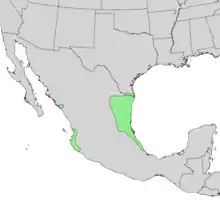Erythrostemon mexicanus
Erythrostemon mexicanus is a species of flowering plant in the pea family, Fabaceae. Common names include Mexican holdback,[2] Mexican caesalpinia, and tabachín del monte.[3] It is native to the extreme lower Rio Grande Valley of Texas[4] in the United States and south to central Mexico.[5] Its range in Mexico includes the northeast and further south along the Gulf coast as well as the Pacific coast in Nayarit, Jalisco, Colima, and a small portion of Sinaloa.[6]
| Erythrostemon mexicanus | |
|---|---|
 | |
| Scientific classification | |
| Kingdom: | |
| (unranked): | |
| (unranked): | |
| (unranked): | |
| Order: | |
| Family: | |
| Genus: | |
| Species: | E. mexicana |
| Binomial name | |
| Erythrostemon mexicana (A.Gray 1861) E. Gagnon & G. P. Lewis 2016 | |
 | |
| Natural range | |
| Synonyms[1] | |
Description
Mexican holdback is a small evergreen tree or large shrub, reaching a height of 3–4.6 m (9.8–15.1 ft) and a spread of 1.8–3 m (5.9–9.8 ft). Leaves are bipinnately-compound and dark green.[7] Each leaf has five to nine pinnae 4–9 cm (1.6–3.5 in) in length.[8] Pinnae are composed of four to five leaflets[7] that are 1–2.5 cm (0.39–0.98 in) long and 0.7–1.3 cm (0.28–0.51 in) wide.[8] Yellow, slightly fragrant flowers are produced on 7.6–15.2 cm (3.0–6.0 in) terminal spikes[7] of 10 to 30.[3] Blooming takes place from February to July, often continuing to October. The fruit is a dehiscent tan or yellow seedpod 5.1–7.6 cm (2.0–3.0 in) in length.[7]
Uses
Mexican holdback is cultivated as an ornamental because of its showy flowers, lush,[3] fine-textured foliage, and drought tolerance.[9]
Ecology
Erythrostemon mexicanus is the host plant for the caterpillars of the curve-winged metalmark (Emesis emesia).[10]
References
| Wikimedia Commons has media related to Erythrostemon mexicanus. |
| Wikispecies has information related to Erythrostemon mexicanus. |
- "Caesalpinia mexicana A. Gray". TROPICOS. Missouri Botanical Garden. Retrieved 2009-11-25.
- "Caesalpinia mexicana A. Gray Mexican holdback". PLANTS Database. United States Department of Agriculture. Retrieved 2009-12-03.
- Nokes, Jill (2001). How to Grow Native Plants of Texas and the Southwest (2 ed.). University of Texas Press. pp. 151–152. ISBN 978-0-292-75573-4.
- "Mexican Caesalpinia, Mexican Poinciana". Benny Simpson's Texas Native Trees. Texas A&M University. Retrieved 2009-01-28.
- "Caesalpinia mexicana". Germplasm Resources Information Network (GRIN). Agricultural Research Service (ARS), United States Department of Agriculture (USDA). Retrieved 2009-11-25.
- Little Jr., Elbert L. (1976). "Map 27, Caesalpinia mexicana". Atlas of United States Trees. 3 (Minor Western Hardwoods). US Government Printing Office. LCCN 79-653298. OCLC 4053799.
- Irish, Mary (2008). Trees and Shrubs for the Southwest: Woody Plants for Arid Gardens. Timber Press. pp. 141–142. ISBN 978-0-88192-905-8.
- Richardson, Alfred (1995). Plants of the Rio Grande Delta. University of Texas Press. pp. 103–104. ISBN 978-0-292-77070-6.
- Gilman, Edward F (October 1999). "Caesalpinia mexicana Mexican Caesalpinia" (PDF). IFAS Extension. University of Florida. Retrieved 2010-11-23.
- "Curve-winged Metalmark Emesis emesia (Hewitson, 1867)". Butterflies and Moths of North America. Retrieved 2009-11-29.
External links
- "Caesalpinia mexicana Mexican bird of paradise". Arid Plant List. University of Arizona. 2006-03-16. Archived from the original on 2009-12-21.